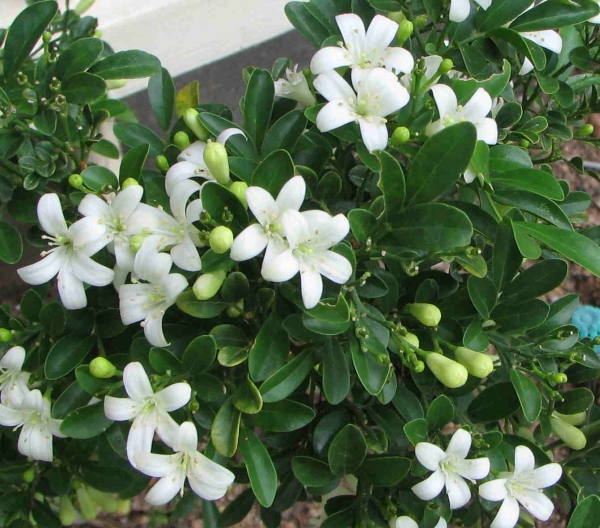Kamuning or Murraya paniculata is a small tree that is famous for its fragrant white flowers that smell like jasmine. Native to Southeast Asia, China and the Malay peninsula, kamuningor Orange Jasmine has pear-shaped leaflets that are dark green and glossy. After each blooming period, its white blossoms turn into orange and scarlet fruits.

Before, kamuning was usually planted as a hedge or accent shrub for landscaping purposes. Today, its glossy evergreen foliage is more popular as fillers in flower arrangements. Recent surveys show that fillers now occupy a substantial share in the cutflower business. A recent survey says that cut foliage or fillers make up almost a third of bouquets compared to 5% 10 years ago. To meet the increasing demand for foliage plants, the Institute of Plant Breeding of the University of the Philippines at Los Baños (IPB-UPLB) has identified techniques to mass produce kamuning successfully. There are two ways to mass propagate kamuning, either through stem cuttings or seeds.
Propagation by stem cuttings
- Preparation of stem cuttings
Secure healthy and woody 13-20 cm long stem cuttings. Remove 5-8 cm of the terminal stem to allow faster rooting. Choose cuttings with mature leaves.
Place the newly harvested cuttings in polyethylene plastic bags then sprinkle with water to prevent from drying. Seal the bags with rubber bands.
- The kulob method
Kamuning stem cuttings root faster in the kulob method wherein the whole system is enclosed in a polypropylene plastic bag. This method helps to maintain the humidity needed to initiate rooting. For extensive rooting, use appropriate media and rooting hormones. The steps involved in this method are as follows:
- Prepare rooting medium composed of an equal mixture combination of sand and coirdust. Drench with 1 tbsp fungicide dissolved in 4 liters of water.
- Dip cuttings either in “quick root powder” or in 50 ppm alpha napthalene acetic acid (ANAA) or Hormex for 30 minutes.
- Stick the cuttings, 4 cm deep, in a 6x6x11 plastic bag containing the medium. Use bigger pots if more cuttings will be planted. A maximum of 4-6 cuttings can be planted in a 6x6x11 plastic pot.
- Enclose the whole system with a polypropylene plastic bag and seal with rubber bands.
- Place the kulob plants under shade.
- Transplanting
After 6-8 weeks, roots are already established. Transplant rooted cuttings as follows:
- Transplant individually in 6x6x11 plastic bags containing either an equal mixture of sand and coir dust or soil and coir dust.
- Acclimatize transplanted plants under partial shade for one week before exposing them to full sunlight. Well-established kamuning plants can tolerate both partial shade and full sunlight conditions.
- After one week, apply complete fertilizer (14-14-14) at 2 tbsp in 4 liters of water. Repeat every other week. Apply urea (46-0-0) at 1 tbsp. dissolved in 4 liters of water once a month. Slow release fertilizer (17-17-17) could be applied once in every three months. Plants that are transplanted should not be fertilized too often.
- Water the plants daily during the dry season and minimally during the rainy season.
Propagation by seeds
- Preparation of seeds
- Harvest ripened seeds from the mother plant. Ripe seeds may be orange/red orange to deep red depending on the variety or strain of the plant.
- Soak the seeds in water for 3 days . After 3 days, remove the pulp of the seeds and wash with clean water.
- Air-dry the seeds for a few hours before sowing.
- Germination
- Sow the seeds by spreading them evenly in a polyethylene bag containing an equal combination of either the following mixture: sand + coconut coirdust or burnt ricehull + sawdust.
- Cover the seeds with 1 cm layer of the medium and place in a shaded area.
- Water the seeds only when the surface of the medium appears dry.
- Transplanting
- Kamuning seeds usually germinate 2-8 weeks after sowing. Transplant seedlings one week after germination or when the first pair of leaves emerges.
- Transplant individually in a 2.5×2.5×5 plastic bag containing an equal combination of any of the following medium:
– garden soil + coirdust
– sand + coirdust
– burnt ricehull + coirdust. - Keep the newly transplanted plants in the shade for at least one month. Kamuning seedlings grow best under partial shade. Direct sunlight causes yellowing and scorching of the leaves.
- Apply complete fertilizer (14-14-14) two weeks after germination at 1 tbsp/4 L of water. Repeat every other week. Urea (46-0-0) at 1 tbsp/4 L of water should also be applied once a month.
- Water the plants daily during the dry season and minimally during the rainy season.
————————————-
For more information, please contact: Dr. Joy Eusebio of the Crops Research Division, PCCARD Los Baños , Laguna at tel no. 049 536-0014 to 536-0020.)
By: Junelyn S. de la Rosa, BAR Digest, October-December 2001 Issue (Vol. 3 No. 4)
